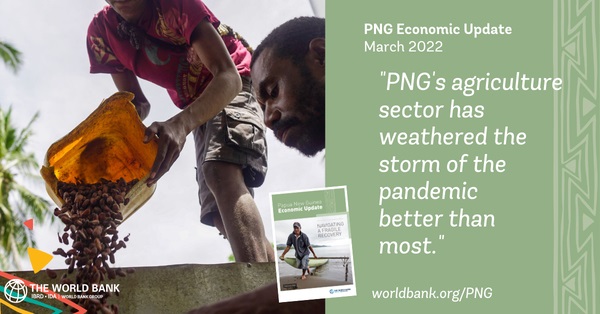The agriculture sector shows signs of weathering the pandemic better than other sectors largely due to additional Government support to SMEs, according to the World Bank’s Papua New Guinea Economic Update for February 2022.
The report highlights vanilla as the star achiever for PNG which it says is poised to become the world’s second largest vanilla producer.

“While bank lending to businesses has been broadly flat since 2019, lending to agriculture is up nearly 50 percent,” the report said.
“The pandemic impacted formal employment in agriculture less than other sectors, with employment up 6 per cent since December 2019 (other employment categories average a 10-percent decline).
“These developments coincided with a sharp reduction in food import spending, which fell by 50 per cent year on year in 2020 (other imports fell by 30 percent).
“The vanilla sector is growing strongly, and other agricultural exports have picked up since the second half of 2020.
“The relatively strong performance of agriculture may reflect additional government financial support to SMEs—the Government has allocated K 280 million (0.3 percent of GDP) to facilitate additional lending by the National Development Bank and Bank South Pacific (BSP).”
The World Bank’s Papua New Guinea Economic Update for February 2022 also highlighted that PNG was on track to becoming the world’s second-largest vanilla producer.
“The December 2017 PNG EU discussed developments in the global vanilla market when prices had skyrocketed—a kilogram of vanilla was more valuable than a kilogram of silver,” it said.
“As the third-largest vanilla producer in the world, PNG experienced a vanilla boom in the Sepik province, where most of the vanilla beans produced by the country are grown.
“What has happened to the vanilla sector in PNG since those heady days?
“Globally—and contrary to expectations—prices have remained high since 2017, although they have been highly volatile, especially at the local level where farmers negotiate with middlemen.
“Madagascar has attempted to institute a minimum export price for vanilla of US250 per kg, encouraging buyers to look elsewhere for their supplies, while the COVID-19 shock put severe downward pressure on prices as demand temporarily collapsed for the gourmet vanilla used in high-end restaurants.
The report said vanilla production had increased by more than 50 per cent since 2017.
“Hard numbers on PNGs vanilla production are patchy; no official data is collected. However, import statistics from PNG’s trading partners suggest that production has increased by more than 50 percent since 2017, with over 360 tonnes exported in 2020,” it said.
“This may partly reflect a decline in unofficial exports across the border to Indonesia, with Aust and Hachmann, a Canada-based vanilla importer, reporting that falling prices and abundant supply in PNG’s neighbor have been making smuggling far less attractive.
“PNG’s prices, however, are some of the lowest in the world, averaging US$146 per kg since 2018, compared to US$385 in Madagascar, US$265 in Indonesia, and US$238 in Uganda.
“Prices can vary for a wide variety of reasons—vanilla type, moisture content, whether the beans have been picked early or ‘bulked out’—but they do suggest that there is room to improve the quality and marketing of PNG’s vanilla crop.
“Encouragingly, Aust and Hachmann’s latest report suggests that quality has been improving, with green vanilla now only harvested at full maturity, and that efforts are being made to dry down black/gourmet vanilla stocks to industrial moisture levels, which should help attract higher prices.
“With vanilla export earnings totaling US$40 million in 2020, vanilla is now a more-important crop to PNG than copra (coconut) and is catching up with cocoa (US$70 million in exports) and coffee (US$125 million).
“If production trends continue, PNG is also on track to become the world’s second-largest vanilla producer, overtaking Indonesia in the coming years.”
***